Rosicrucians: Facts And History About The Mysterious Secret Society
Ellen Lloyd – MessageToEagle.com – Who were the Rosicrucians? Why did this society conceal its identity under various names? Who was the mysterious author of the Order’s manifestos? Who was Christian Rosenkreutz?
Why were so many people alarmed when they learned about the Order’s existence?
Rosicrucians possess secret ancient knowledge, passed down through the ages. Join us a long journey and explore the esoteric secrets of this ancient Order and its enigmatic history. The ancient history of the Rosicrucians can be traced back to the mystery schools of ancient Egypt.
In this article we examine facts and history of the Rosicrucians – one of the world’s most mysterious secret societies.
The Emergence Of The Rosicrucian Order In Europe
In the middle of the 15th century a mystic sect known as the Order of the Rose Cross could be encountered in some European countries.
The sect’s existence was made public in the 18th century, but its history is much older.
On March 3, 1623 the inhabitants of Paris, France discovered several mysterious posters hanging on the streets’ buildings. This was the announcement to the world, declaring the existence of a previously unknown esoteric order called the Brotherhood of the Rose Cross.
The manifesto stated:
We, the deputies of the principal college of the brethren of the Rosie Cross, have taken up our abode, visible and invisible, in this city, by the grace of the
Most High, towards whom are turned the hearts of the just. We show and teach without any books or symbols whatever, and we speak all sorts of languages in the countries wherein we deign to dwell, to draw mankind, our fellows, from error and to save them from death.”
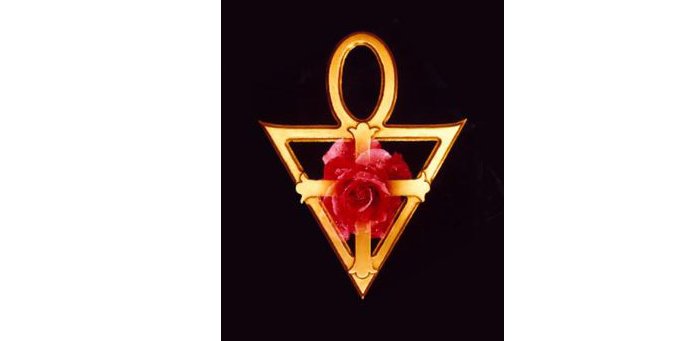
„For a long time this strange placard was the sole topic of conversation in all public places,” says Charles Mackay, author of the book Extraordinary Popular Delusions and the Madness of Crowds.
“Some few wondered, but the greater number only laughed at it. In the course of a few weeks, two books were published, which raised the first-alarm respecting this mysterious society, whose dwelling-place no one knew, and no members of which had ever been seen. The first was called a history of The frightful Compacts entered into between the Devil and the pretended “Invisibles”; with their damnable Instructions, the deplorable Ruin of their Disciples, and their miserable end. The other was called An Examination of the new unknown Cabala of the Brethren of the Rose-Cross, who have lately inhabited the City of Paris; with the History of their Manners, the Wonders worked by them, and many other particulars. “
People In Europe Panicked When They Learned About The Brotherhood Of The Rose Cross
The books written by the Brotherhood of the Rose Cross sold well and this led to panic among many Europeans.
Citizens of Paris feared this mysterious sect, whose members they had never seen. It was believed that the Rosicrucians could transport themselves from one place to another with the speed of thought. It was also believed the brotherhood’s members took delight in cheating and tormenting unhappy citizens, especially those who had sinned against the laws of morality.
Who Was The Author Of The Manifestos?
It was not the first time Europeans heard of this secret society. A few years earlier, the Order had already published three manifestos, the Fama Fraternitatis, the Confessio Fraternitatis, and the Chymical Wedding of Christian Rosenkreutz. The manifestos were published in 1640, 1615 and 1616 respectively.
The first two manifestos were published anonymously. There is speculation that Francis Bacon was the author, however, the manifestos have historically been attributed to Johann Valentin Andreae who was a German theologian, Lutheran minister and Grand Master of the Prieuré de Sion from 1637-1654.
Was The Brotherhood Of The Rose Cross A Threat To Christianity And The Church?
It did not take long before people began wondering if this new secret society posed a threat to Christianity and the Church.
The Rosicrucians’ manifestos, the Fama Fraternitatis, the Confessio Fraternitatis were filled with references to the Kabbalah, Hermeticism, Alchemy, but also Christianity.
It is important to keep in mind that although the Brotherhood of the Rose Cross was unknown to most people in the 15th century, Rosicrucianism itself was “no new thing”. The Order’s teachings were a only a revival of still earlier forms of Initiation, and the Order was a lineal descendant of the Philosophies of the Chaldean Magi, of the Egyptian priests, of the Neo-Platonists, of the Hermetists of Alexandria, of the Jewish Kabalists and of Christian Kabalists such as Raymond Lully and Pic de Mirandola.
The traditional origins of the Rosicrucians go back to the mystery schools of ancient Egypt. In these schools, enlightened mystics gathered together to study the mysteries of the universe, nature, and humanity. This was the reason they were later called “mystery schools”.
“About 1500 B.C., Pharaoh Thutmose III combined these schools into a single order bound by a single set of rules. About a century later, Amenhotep IV-known more commonly as Akhnaton-created a unique body of teaching for all members of this order. During his reign he also founded the first monotheistic religion in historical record.
From Egypt the Order spread to Greece, an event in which Pythagoras played a singular role, and it then spread to medieval Europe, with the alchemists and Templars being agents of this Tradition. In the following centuries, the philosophers of the Renaissance and spiritually minded students of the modern period contributed to its expansion, both in the East and West. Since freedom of conscience was often lacking in past societies, the Order concealed its identity under various names during its history.” (Rosicrucian Order, H. Spencer Lewis)
Ancient History Of The Rosicrucian Order – Preserving Secret Ancient Knowledge
According to Harvey Spencer Lewis (1883-1939), the founder of the Ancient and Mystical Order Rosae Crucis (AMORC) in the United States, Rosicrucianism dates back to 1489 B.C when a group of male and female mystic scholars, studying under Pharaoh Thutmose III decided to make their order secret, calling it simply the order or brotherhood.
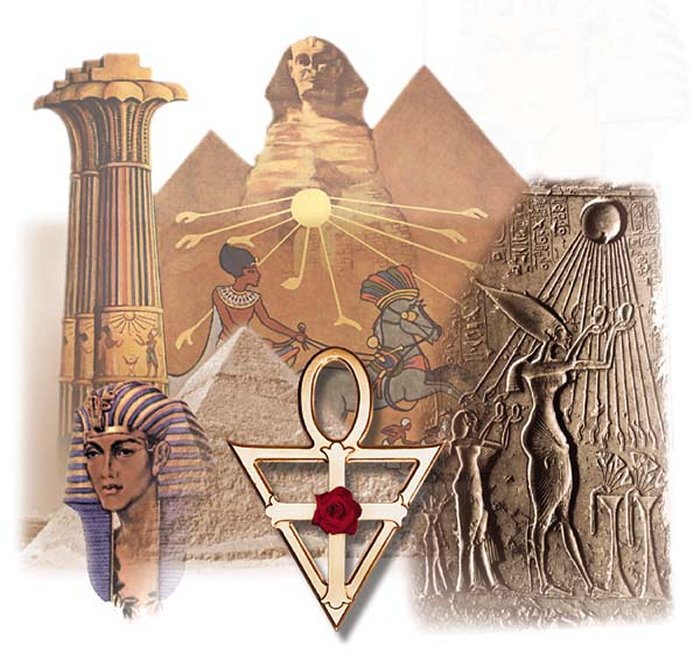
The order prospered and succeeding pharaohs continued as Grand Masters through Amenhotep IV, great-great-grandson of Thutmose III.
Amenhotep IV was an extraordinary and courageous pharaoh who was unfortunately born ahead of his time (1388 B.C.-1350B.C.).
Amenhotep IV was much too controversial in the eyes of the ancient Egyptians. He rejected the worship of the old gods and the principal deity Amon and established one supreme deity.
This was unacceptable to the ancient Egyptians who at the time worshiped a number of different gods, and as a result, Amenhotep IV made enemies of the priests.
However, this brave pharaoh was not very concerned with public opinion and ancient traditions.
He changed his name to Akhnaton, meaning “glory to Aton”, the sub-symbol of the one true God. His previous name Amenhotep meant “Amon is satisfied”.
Akhnaton continued to challenge and question the old Egyptian traditions and religion. He moved the capital city from Thebes, which was sacred to Amon, to a place called Khut-en-Aton, also known as El Amarna. There, shaped like a cross, he built a temple for the Brotherhood.
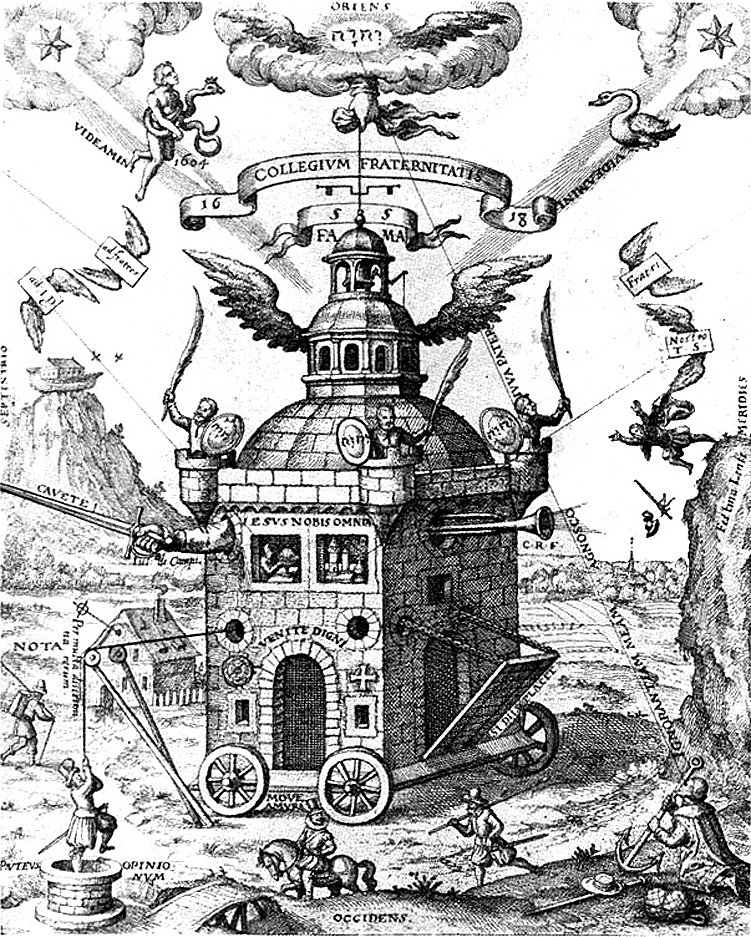
During the reign of Akhnaton, the Rosicrucians could practice their teachings in peace, but everything ended when the pharaoh died.
Shortly after the death of Akhnaton, Amon-Ra was reinstated as the chief god and the brotherhood fled to the temple of El Amarna.
The members of the Order lived in isolation and for the next several centuries they concentrated on preserving the sacred truths of Akhnaton.
Secret knowledge was passed down to worthy students. Prominent figures like King Solomon, Plato, Pythagoras, Solon, and Ammonius Saccas, all studied under the Rosicrucians.
It is believed that after the death of Pharaoh Akhnaton, the legendary Hermes Trismegistus served as a Grand Master.
Christian Rosenkreuz Founded The Rosicrucian Order
The identity of Christian Rosenkreuz still remains shrouded in mystery, but according to three Rosicrucian Manifestos, the Rosicrucian Order was founded by Christian Rosenkreuz, a German noble of the 14th century.
Christian Rosenkreuz was a doctor who discovered and learned esoteric wisdom on a pilgrimage to the Middle East among Turkish, Arab and Persian sages, possibly Sufi or Zoroastrian masters.
After a long travel in the East, Rosenkreuz founded the Brotherhood on his return.
In his essay on “Rosicrucians and Freemasons” Thomas de Quincy wrote:
“Christian Rosycross, of noble descent, having upon his travels into the East and into Africa learned great mysteries from Arabians, Chaldeans, etc., upon his return to Germany established, in some place not mentioned, a secret society composed at first of four—afterwards of eight—members, who dwelt together in a building called the House of the Holy Ghost, erected by him: to these persons, under a vow of fidelity and secrecy, he communicated his mysteries.
After they had been instructed, the society dispersed agreeably to their destination, with the exception of two members, who remained alternately with the founder.”
Christian Rosenkreuz’s Death And Mysterious Grave
There is very little information about Christian Rosenkreutz’s death. It is believed he died at the age of a hundred years.
His death was known to the Society, but not his grave. It was a common practice of the first Rosicrucians to conceal their burial places even from each other.
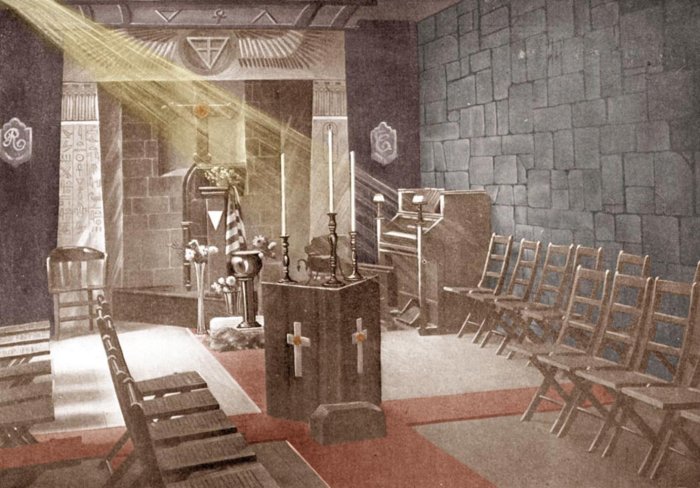
It is described that his body was discovered by a Brother of the Order, in a perfect state of preservation, 120 years after his death which occurred in absolute secrecy, as Rosenkreuz had predicted, in a heptagonal chamber erected by himself as a storehouse of knowledge.
The vault was a heptagon. Every side was five feet broad and eight feet high. It was illuminated by an artificial sun. In the centre was placed, instead of a grave-stone, a circular altar with a little plate of brass, whereon these words were inscribed: This grave, an abstract of the whole world, I made for myself while yet living (A. C. R. C. Hoc Universi compendium vivus mihi sepulchrum feci).
About the margin was—To me Jesus is all in all (Jesus mihi omnia).
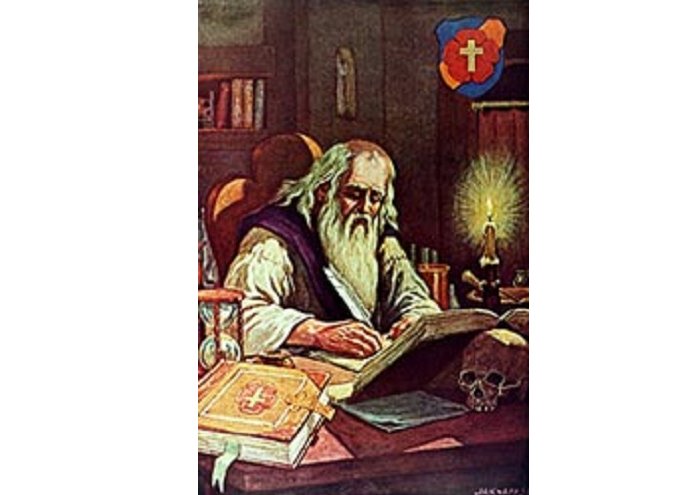
In the center were four figures enclosed in a circle by the revolving legend : Nequaquam vacuum legis jugum. Libertas Evangelii. Dei gloria intacta. (The empty yoke of the law is made void. The liberty of the gospel. The unsullied glory of God).
Each of the seven sides of the vault had a door opening into a chest. Inside the vault were secret books of the order and the Vocabularium of Paracelsus. There were also mirrors, small bells, burning lamps, marvelous mechanisms of music, etc., all so contrived that, after the lapse of many centuries, if the whole order should have perished, it might be re-established by means of this vault.
The true identity of Christian Rosenkreutz still remains a controversial subject. Some scholars maintain the legendary founder of the Rosy Cross never existed. However, many are convinced that stories of Rosenkreutz are entirely true.
Written by – Ellen Lloyd – MessageToEagle.com
Copyright © MessageToeagle.com All rights reserved. This material may not be published, broadcast, rewritten or redistributed in whole or part without the express written permission of MessageToeagle.com
Expand for referencesRelated Posts
-
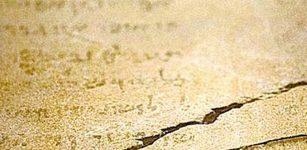 Mystery Of The Second Gabriel Stone And The Man Resurrected By Archangel Gabriel
No Comments | Feb 18, 2014
Mystery Of The Second Gabriel Stone And The Man Resurrected By Archangel Gabriel
No Comments | Feb 18, 2014 -
 DNA Sheds Light On Ancient History Of Dogs All The Way To The Ice Age
No Comments | Oct 30, 2020
DNA Sheds Light On Ancient History Of Dogs All The Way To The Ice Age
No Comments | Oct 30, 2020 -
 Remarkably Well-Preserved 2,500-Year-Old Canoe Discovered In Swiss Lake
No Comments | Sep 18, 2023
Remarkably Well-Preserved 2,500-Year-Old Canoe Discovered In Swiss Lake
No Comments | Sep 18, 2023 -
 Child Finds Impressive 1,800-Year-Old Ring Engraved With Goddess Minerva On Mount Carmel, Israel
No Comments | Jul 20, 2024
Child Finds Impressive 1,800-Year-Old Ring Engraved With Goddess Minerva On Mount Carmel, Israel
No Comments | Jul 20, 2024 -
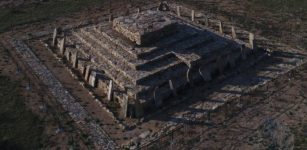 Intriguing 3,400-Year-Old Multipurpose Pyramid Found In Kazakhstan
No Comments | Nov 5, 2023
Intriguing 3,400-Year-Old Multipurpose Pyramid Found In Kazakhstan
No Comments | Nov 5, 2023 -
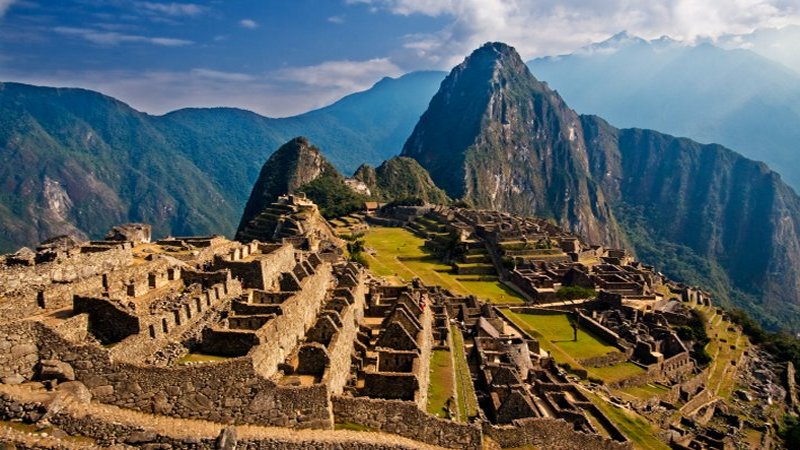 Machu Picchu Was Built With The Royal Unit System – New Research Suggests
No Comments | Jan 14, 2021
Machu Picchu Was Built With The Royal Unit System – New Research Suggests
No Comments | Jan 14, 2021 -
 Cosmic Impact Destroyed Huge Ancient City In The Jordan Valley – Evidence Has Been Found!
No Comments | Sep 22, 2021
Cosmic Impact Destroyed Huge Ancient City In The Jordan Valley – Evidence Has Been Found!
No Comments | Sep 22, 2021 -
 Europe’s Oldest Lakeside Settlement Protected By Defensive Barricade of Spikes- Discovered
No Comments | Aug 14, 2023
Europe’s Oldest Lakeside Settlement Protected By Defensive Barricade of Spikes- Discovered
No Comments | Aug 14, 2023 -
 Mysterious Rock Art By Unknown Ancient Culture Found In Venezuela
No Comments | Jul 13, 2024
Mysterious Rock Art By Unknown Ancient Culture Found In Venezuela
No Comments | Jul 13, 2024 -
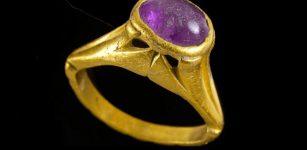 Ancient Greek Amethyst Ring To Ward Off A Hangover Discovered At The World’s Largest Byzantine Wine Factory In Yavne, Israel
No Comments | Nov 12, 2021
Ancient Greek Amethyst Ring To Ward Off A Hangover Discovered At The World’s Largest Byzantine Wine Factory In Yavne, Israel
No Comments | Nov 12, 2021

